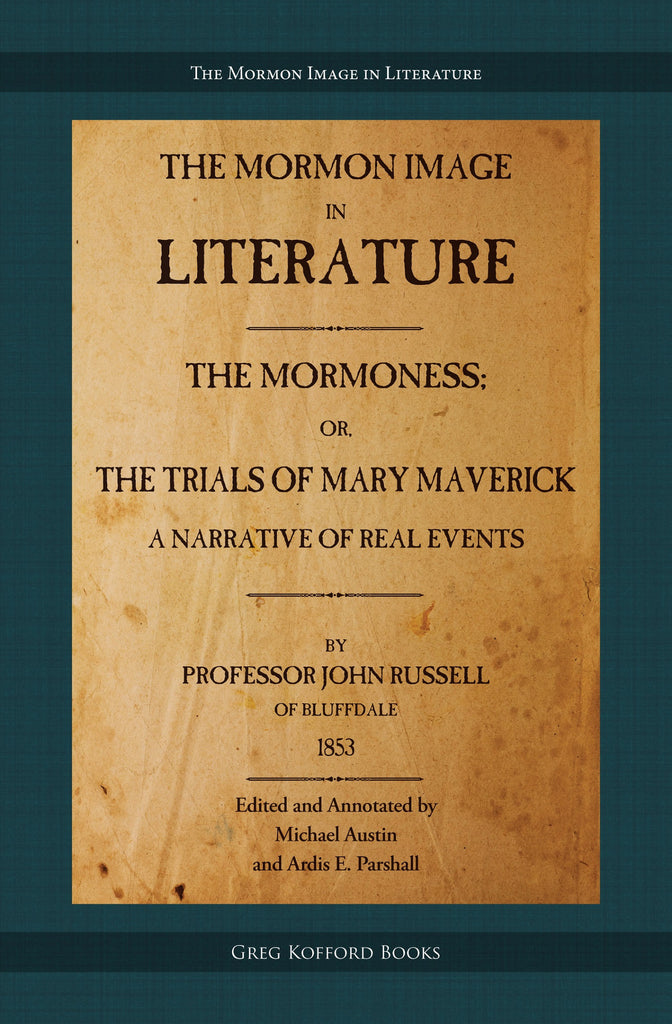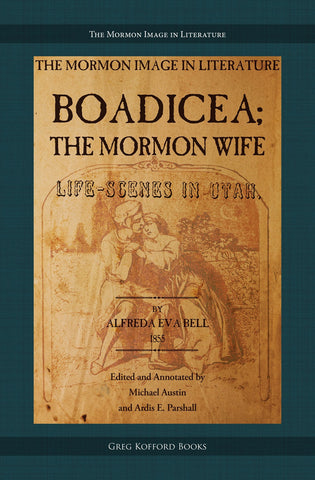The Mormoness; Or, The Trials Of Mary Maverick: A Narrative Of Real Events
$12.95
by John Russell
Edited and Annotated by Michael Austin and Ardis E. Parshall“Virtually the only work of Mormon fiction derived from non-church sources that is sympathetic to Mormonism.” — The Standard Examiner
“Illustrate[s] . . . the wide variety with which Mormonism itself was received within the early American cultural context.” — Dialogue: A Journal of Mormon Thought



Available in ebook for Kindle, Nook, Kobo, Google Play, and Apple.
Also available through Amazon.
Download a free sample preview.
Part of The Mormon Image in Literature series
Book Description:
Published in 1853, the first American novel about the Mormons is also one of the best. John Russell, an Illinois journalist and educator, witnessed the persecution in Missouri and Illinois and generally sympathized with the Saints. The Mormoness tells the story of Mary Maverick, the heroine of the novel, who joined the Mormon Church when her husband was converted in Illinois. Though not initially a believer, Mary embraces her identity as “the Mormoness” when her husband and son are killed in a Haun’s Mill-like massacre–and at the end of the novel, she must find a way to forgive the killer.
Virtually unavailable until now, Michael Austin and Ardis E. Parshall's fresh transcription, introduction, notes, and appendices enable readers to rediscover a compassionate and insightful outsider's view of early Mormonism.
AuthorCast Interview with One of the Editors:
Comprehensive Table of Contents:
.
Introduction
John Russell the Writer
The Trials of Mary Maverick
Some Notes on the Text and Appendices
Timeline for John Russell
Bibliography of John Russell’s Works
CHAPTER I.
CHAPTER II.
CHAPTER III.
CHAPTER IV.
CHAPTER V.
Appendix A: John Russell, of Bluffdale, Illinois. (By S.G. Russell.)
Appendix B: John Russell to Thomas Gregg, July 7, 1841
Appendix C: From The Serpent Uncoiled
CHAPTER III. ABSURDITY OF UNIVERSALISM.
SECTION I.
SECTION II.
SECTION III.
SECTION IV.
CHAPTER VI. CONCLUDING REFLECTIONS.
Q&A with the Author:
.
Q. What led to doing this series?
MA: The idea for the series came out of other projects. And it started with The Mormoness; or The Trials of Mary Maverick. I was doing a survey of the Mormon image in the 19th century for another book project, and I wanted to start with Russell’s book, which most of the literature cites as the first American novel to treat Mormonism in any way. And a fair number of Mormon critics labeled it an “anti-Mormon” book in the same vein as Boadicea, the Mormon Wife or Female Life among the Mormons. Two things happened when I went to read it. First, I could not find a readable copy anywhere. The only thing that my ILL librarian could pull up was a copy that had been printed from microfilm and xeroxed multiple times, with large areas of text that were completely unreadable. But I could read enough of it to see that it was not an anti-Mormon book at all, but was more sympathetic towards the Saints than almost anything written by a non-Mormon in the entire 19th century.
At the time, Ardis and I were working on another article together and were e-mailing back and forth nearly every day. I mentioned this to her, and, within a week or so, she was able to find an original copy of the book, transcribe it completely, and send it to me for use in my own work. We were both really impressed with the fact that one of the most historically significant works of literature about Mormonism ever published had all but disappeared from the world and that much of the scholarship about the book was inaccurate. That’s when we hit on the idea of a critical edition. This was around the time of spring break, so I took a few days off and drove to the Lincoln Library in Springfield, where all of John Russell’s papers are housed. Through his correspondence, I could see that he really was sympathetic to the Mormons and that he based The Mormoness on real events surrounding the Haun’s Mill Massacre that he had heard about directly from Sidney Rigdon and Parley P. Pratt, who stayed with him briefly after the Mormons were forced to leave Missouri. A critical edition seemed like the ideal way to share both the text and the context with modern readers.
And the more we talked, the more we realized that a lot of books by and about Mormons written in the 19th century have all but disappeared. This includes the sensational “dime novels” of the late 19th century, as well as some largely positive novels about Mormons by non-Mormons and some of the first attempts of Mormons to create their own literature in the Utah Territory. Ardis had done a lot of work with some of these novels, and I had recently begun haunting the archives in search of dime novels and penny dreadfuls. We realized that we already had enough source material for a pretty expansive series, and we felt that strong critical editions would serve the joint purposes of making material available that has not been available for years and giving this material a historical context that it has never had before.
Q: Beyond the literary value of these books, what other applications do you see these volumes being useful for?
MA: Much of this work will be just as interesting to historians as to scholars of literature. In fact, some of the work with the least literary merit has the greatest historical interest. Boadicea: The Mormon Wife, which will be the second volume in the series, will probably never be accused of literary greatness. But it has been written about by some of the top figures in Mormon History: Leonard Arrington, Terryl Givens, Sarah Barringer Gordon, Paul W. Reeve. All of them have been interested in Boadicea. And, not to say too much here, but the author of Boadicia has always been a mystery to scholars, and we are pretty sure that we have cracked it. We will be positing and making a case for authorship that nobody has ever made before.
Q: How does Mormon literature from the late 19th and early 20th centuries differ from Mormon literature of today?
MA: The literature of the 19th century had very little subtlety when it came to portraying Mormons. The overwhelming majority of volumes featured Mormon elders living in harems and forming Danite bands to hunt down and kill dissenters. And this was not just in the tawdry literature. Both Robert Louis Stevenson and Arthur Conan Doyle wrote novels that portrayed Mormons in these ways. And the books written by Mormons were just as bad in the other direction—they portrayed Mormonism as heroic and noble creatures unreasonably persecuted by a cruel and heartless world. Today, for the most part, both Mormons and non-Mormons are finding a more plausible middle ground.
Q: Most of the books in your series will be authored by non-Mormon writers. Why do you think non-LDS authors were interested in writing novels about Mormon characters?
MA: Mormonism was just about the most interesting thing that happened in America in the 19th century. A prophet finds golden plates in the ground and produces an epic of the history of Ancient America. He builds a huge following and founds one of the largest cities in the West. He is assassinated, and his people settle the barren wilderness. And somewhere in there, polygamy happens. These were amazing stories that people couldn’t get enough of. And Mormons fit very well into most of the standard tropes of the popular literature of the day—usually as the bad guys. I can’t imagine anything that could have captured the interest of more people for a longer time than the Mormons.
Q: Can you give us a tease for future volumes?
Well, here are some things that readers will encounter as the series progresses:
- A novella by a Mormon General Authority that was the basis for a stage play that ran briefly on Broadway.
- An anti-Mormon novel by an English writer that became part of a report written by one of the most famous British politicians of all time—as well as the basis for the most famous silent film about Mormons ever produced.
- A ghost story featuring a sympathetic Mormon character written by one of the attorneys who represented Homer Plessy in the famous Plessy v. Ferguson decision of the Supreme Court.
- A novel set in the great caverns below Salt Lake City that connect the homes of all Mormons to the Great Salt Lake.
- The full text of a famous monologue about the Mormons in Utah that was performed before sold out crowds at the Egyptian Hall in London in 1866.
And that’s just for starters.
Praise for The Mormoness:
“Written by a minister/educator/journalist of some note named Professor John Russell, it’s 1853 publication, in serial form, is significant because it’s virtually the only work of Mormon fiction derived from non-church sources that is sympathetic to Mormonism.” — Doug Gibson, The Standard Examiner
“The work that Michael Austin and Ardis E. Parshall have done in preparing useful critical material allows for any reader to approach and appreciate this text. . . . Highly recommended for those interested in the cultural history of America, the West, and Mormonism.” — Jenny Webb, Association for Mormon Letters
“For those interested in how contemporary authors viewed the church of Joe Smith, The Mormoness is worth a look.” — Steve Evans, By Common Consent
“Illustrate[s] . . . the wide variety with which Mormonism itself was received within the early American cultural context. . . . there is a certain Mormon textuality that emerges from these pages: experimental, provocative, heartfelt, and profoundly human.” — Jenny Webb, Dialogue: A Journal of Mormon Thought
About the Editors:
Michael Austin is the author or editor of seven books and more than 50 articles, book chapters, and reviews, including Re-reading Job: Understanding the Ancient World’s Greatest Poem. He is currently the Provost and Vice President of Academic Affairs at Newman University in Wichita, Kansas.
Ardis E. Parshall is a historian, freelance researcher specializing in Mormon history, and author. She co-edited with Paul Reeve Mormonism: A Historical Encyclopedia and is currently writing She Shall Be an Ensign, a history of the LDS Church told through the lives of Mormon women. She blogs at Keepapitchinin.
More Information:
114 pages
ISBN 978-1-58958-507-2 (paperback)
Published January 2016




Share this item: